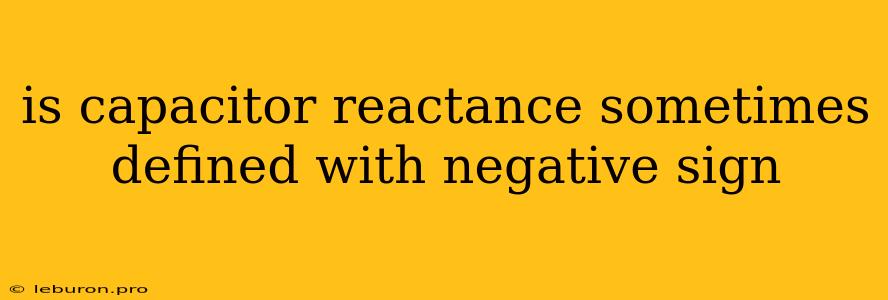Capacitive reactance is a crucial concept in electrical engineering, representing the opposition offered by a capacitor to the flow of alternating current (AC). It is often described as the "imaginary" component of impedance, a complex quantity that encapsulates both resistance and reactance. While capacitive reactance is typically expressed as a positive value, there are instances where it's defined with a negative sign. This article delves into the reasons behind this sign convention and its implications in circuit analysis.
Understanding Capacitive Reactance
Capacitors store electrical energy in an electric field. When an AC voltage is applied across a capacitor, the capacitor charges and discharges continuously, resulting in a current flow. This current flow is not directly proportional to the voltage but is related to the rate of change of voltage. The opposition to this current flow due to the capacitor's charging and discharging behavior is termed capacitive reactance.
The value of capacitive reactance (Xc) is inversely proportional to the frequency (f) of the AC signal and the capacitance (C) of the capacitor:
Xc = 1 / (2πfC)
High frequency, low reactance: As the frequency increases, the capacitor charges and discharges faster, leading to a decrease in capacitive reactance. This implies that the capacitor offers less opposition to the current flow at higher frequencies.
High capacitance, low reactance: Similarly, a larger capacitance value means the capacitor can store more charge, resulting in a lower reactance. This signifies a smaller opposition to current flow for capacitors with larger capacitances.
The Negative Sign Convention
While the formula above provides the magnitude of capacitive reactance, it doesn't explicitly indicate the sign. The convention of using a negative sign for capacitive reactance arises from the mathematical representation of AC circuits using phasors and complex numbers.
Phasor Representation: In AC circuit analysis, phasors are used to represent sinusoidal quantities like voltage and current. These phasors rotate in a complex plane, with their magnitude representing the amplitude of the signal and their angle representing the phase shift.
Complex Impedance: Impedance (Z) in AC circuits is a complex number that combines resistance (R) and reactance (X) as follows:
Z = R + jX
where 'j' is the imaginary unit (√-1).
Capacitive Reactance: Since the current through a capacitor leads the voltage by 90 degrees, capacitive reactance is represented as -jXc. This negative sign indicates that the capacitive reactance vector in the complex plane is pointing downwards along the imaginary axis, opposite to the direction of inductive reactance.
Implications of the Negative Sign:
- Phase Shift: The negative sign in capacitive reactance reflects the phase shift between voltage and current in a capacitor. The negative sign indicates that the current leads the voltage by 90 degrees.
- Circuit Calculations: The negative sign is crucial in complex impedance calculations for AC circuits. When summing impedances in series or parallel, the signs of reactances are considered.
- Power Factor: The negative sign in capacitive reactance contributes to the power factor of an AC circuit. A circuit with capacitive reactance has a leading power factor, implying that the current leads the voltage.
When is the Negative Sign Not Used?
While the negative sign convention for capacitive reactance is prevalent in AC circuit analysis using complex numbers, it's not always used in other contexts.
- Magnitude Only: When dealing with the magnitude of capacitive reactance, such as in calculating the cutoff frequency of a filter, the negative sign is often omitted.
- Simplified Analysis: In some simplified circuit analysis where phase information is not critical, the negative sign might be ignored.
Significance of the Negative Sign
The negative sign associated with capacitive reactance is a convention that stems from the phase relationship between voltage and current in a capacitor. While it may seem trivial in some cases, it plays a vital role in complex impedance calculations, determining phase angles, and influencing the power factor of AC circuits.
Conclusion
The sign convention for capacitive reactance, while seemingly subtle, is a fundamental concept in AC circuit analysis. The negative sign reflects the phase relationship between voltage and current, providing insights into the circuit's behavior and facilitating accurate impedance calculations. Understanding the origin and significance of this sign is crucial for engineers and students working with AC circuits and capacitive components. The negative sign in capacitive reactance, therefore, plays an important role in understanding the behavior of AC circuits and is essential for accurate circuit analysis and design.
